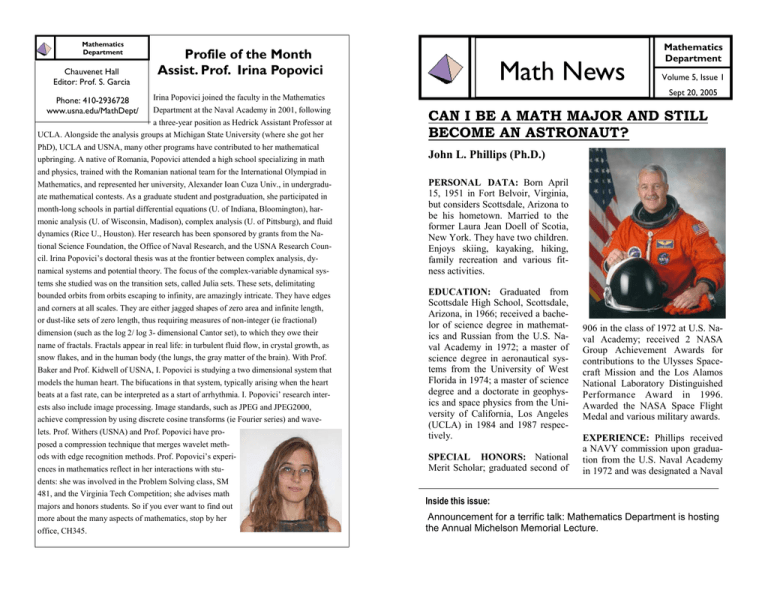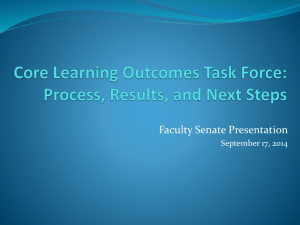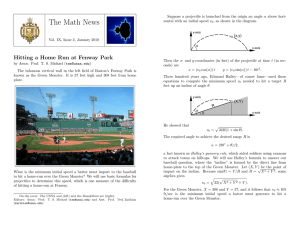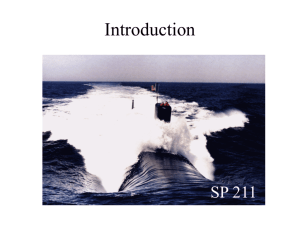Profile of the Month Assist. Prof. Irina Popovici
advertisement

Mathematics Department Chauvenet Hall Editor: Prof. S. Garcia Profile of the Month Assist. Prof. Irina Popovici Irina Popovici joined the faculty in the Mathematics Department at the Naval Academy in 2001, following a three-year position as Hedrick Assistant Professor at UCLA. Alongside the analysis groups at Michigan State University (where she got her PhD), UCLA and USNA, many other programs have contributed to her mathematical upbringing. A native of Romania, Popovici attended a high school specializing in math and physics, trained with the Romanian national team for the International Olympiad in Mathematics, and represented her university, Alexander Ioan Cuza Univ., in undergraduate mathematical contests. As a graduate student and postgraduation, she participated in month-long schools in partial differential equations (U. of Indiana, Bloomington), harmonic analysis (U. of Wisconsin, Madison), complex analysis (U. of Pittsburg), and fluid dynamics (Rice U., Houston). Her research has been sponsored by grants from the National Science Foundation, the Office of Naval Research, and the USNA Research Council. Irina Popovici’s doctoral thesis was at the frontier between complex analysis, dynamical systems and potential theory. The focus of the complex-variable dynamical systems she studied was on the transition sets, called Julia sets. These sets, delimitating bounded orbits from orbits escaping to infinity, are amazingly intricate. They have edges and corners at all scales. They are either jagged shapes of zero area and infinite length, or dust-like sets of zero length, thus requiring measures of non-integer (ie fractional) dimension (such as the log 2/ log 3- dimensional Cantor set), to which they owe their name of fractals. Fractals appear in real life: in turbulent fluid flow, in crystal growth, as snow flakes, and in the human body (the lungs, the gray matter of the brain). With Prof. Baker and Prof. Kidwell of USNA, I. Popovici is studying a two dimensional system that models the human heart. The bifucations in that system, typically arising when the heart beats at a fast rate, can be interpreted as a start of arrhythmia. I. Popovici’ research interests also include image processing. Image standards, such as JPEG and JPEG2000, achieve compression by using discrete cosine transforms (ie Fourier series) and wavelets. Prof. Withers (USNA) and Prof. Popovici have proposed a compression technique that merges wavelet methods with edge recognition methods. Prof. Popovici’s experiences in mathematics reflect in her interactions with students: she was involved in the Problem Solving class, SM 481, and the Virginia Tech Competition; she advises math majors and honors students. So if you ever want to find out more about the many aspects of mathematics, stop by her office, CH345. Phone: 410-2936728 www.usna.edu/MathDept/ Math News Mathematics Department Volume 5, Issue 1 Sept 20, 2005 CAN I BE A MATH MAJOR AND STILL BECOME AN ASTRONAUT? John L. Phillips (Ph.D.) PERSONAL DATA: Born April 15, 1951 in Fort Belvoir, Virginia, but considers Scottsdale, Arizona to be his hometown. Married to the former Laura Jean Doell of Scotia, New York. They have two children. Enjoys skiing, kayaking, hiking, family recreation and various fitness activities. EDUCATION: Graduated from Scottsdale High School, Scottsdale, Arizona, in 1966; received a bachelor of science degree in mathematics and Russian from the U.S. Naval Academy in 1972; a master of science degree in aeronautical systems from the University of West Florida in 1974; a master of science degree and a doctorate in geophysics and space physics from the University of California, Los Angeles (UCLA) in 1984 and 1987 respectively. SPECIAL HONORS: National Merit Scholar; graduated second of 906 in the class of 1972 at U.S. Naval Academy; received 2 NASA Group Achievement Awards for contributions to the Ulysses Spacecraft Mission and the Los Alamos National Laboratory Distinguished Performance Award in 1996. Awarded the NASA Space Flight Medal and various military awards. EXPERIENCE: Phillips received a NAVY commission upon graduation from the U.S. Naval Academy in 1972 and was designated a Naval Inside this issue: Announcement for a terrific talk: Mathematics Department is hosting the Annual Michelson Memorial Lecture. Page 2 Math News CAN I BE A MATH MAJOR AND STILL BECOME AN ASTRONAUT ? (Cont.) Aviator in November 1974. He trained in the A-7 Corsair Aircraft at Naval Air Station Lemoore, California and made overseas deployment with Attack Squadron 155 aboard the USS Oriskany and USS Roosevelt. Subsequent tours of duty included NAVY recruiting in Albany, New York, and flying the CT-39 Sabreliner Aircraft at Naval Air Station North Island, California. After leaving the NAVY in 1982, Phillips enrolled as a graduate student at UCLA. While at UCLA he carried out research involving observations by the NASA Pioneer Venus Spacecraft. Upon completing his doctorate in 1987, he was awarded a J. Robert Oppenheimer Postdoctoral Fellowship at Los Alamos National Laboratory in New Mexico. He accepted a career position at Los Alamos in 1989. While there, Phillips performed research on the sun and the space environment. From 1993 through 1996 he was Principal Investigator for the Solar Wind Plasma Experiment aboard the Ulysses Spacecraft as it executed a unique trajectory over the poles of the sun. He has authored 156 scientific papers dealing with the plasma environments of the sun, earth, other planets, comets and spacecraft. Phillips has logged over 4,400 flight hours and 250 carrier landings. He served as a NAVY reservist from 1982 to 2002, as an A-7 pilot and in various non-flying assignments. He retired in 2002 with the rank of Captain, USNR. NASA EXPERIENCE: Selected by NASA in April 1996, Phillips reported to the Johnson Space Center in August 1996. After completing astronaut candidate training, he held various jobs in the Astronaut Office, including systems engineering and CAPCOM for the International Space Station. He flew aboard STS100 in 2001, logging nearly 12 days and 5 million miles in space. He served as a backup to ISS Expedition-7, completing that assignment in February 2003. Phillips is currently the NASA ISS Science Officer and Flight Engineer on Expedition-11 and is living and working aboard the International Space Station on a six-month tour of duty. Expedition-11 was launched from the Baikonur Cosmodrome in Kazakhstan on April 14, 2005 aboard Soyuz and docked with the ISS on April 16, 2005. Following 8-days of joint operations and handover briefings, they replaced the Expedition10 crew who returned to earth aboard Soyuz. Expedition-11 plans call for two spacewalks, the first in August from the U.S. Airlock Quest in U.S. spacesuits, and the second, in September, in Russian spacesuits from the Pirs Airlock. The spacewalkers will continue outfitting the Volume 5, Issue 1 Page 3 Station's exterior and work with scientific experiments. SPACE FLIGHT EXPERIENCE: STS-100 Endeavour (April 19 to May 1, 2001). During the 12-day, 187 orbit mission, the crew successfully delivered and installed the Canadarm-2 Robotic Arm. They also delivered experiments and supplies aboard the Multi-Purpose Logistics Module Raffaello on its maiden flight. Phillips was the Ascent/Entry Flight engineer and was the intravehicular activity coordinator during two space walks. Article from: http://www.jsc.nasa.gov/Bios/htmlbios/phillips.html MICHELSON MEMORIAL LECTURE: THE SHAPE OF SPACE On Wednesday, 21 September 2005, the USNA Class of 1969 will sponsor the 25th annual Michelson Memorial Lecture in the Mahan Hall Auditorium. This year’s speaker is Dr. Jeffrey Weeks, a freelance mathematician and former MacArthur Fellow (1999-2004). He will be speaking on “The Shape of Space.” His description of his talk is as follows. “When we look out on a clear night, the universe seems infinite. Yet this infinity might be an illusion. During the first half of the presentation, computer games will introduce the concept of a ‘multiconnected universe’. Interactive 3D graphics will then take the viewer on a tour of several possible shapes for space. Finally, we'll see how recent satellite data provide tantalizing clues to the true shape of our universe. The only prerequisites for this talk are curiosity and imagination.” Dr. Weeks has an A.B. from Dartmouth College and a Ph.D. from Princeton University, both in mathematics. His main interests are geometry, topology, cosmology and education. Question of the Month Find a 2 digit number, the sum of whose digits is equal to the square of its cube root. E-mail your answer to Prof. Garcia smg@usna.edu. Among those with the right answer, a randomly chosen midshipman will get to choose between a fantastic math water bottle or a cool koozie. The symbol used on the head of Math News is one of the Platonic Solids. Ref. http://mathworld.wolfram.com/PlatonicSolid.html.



